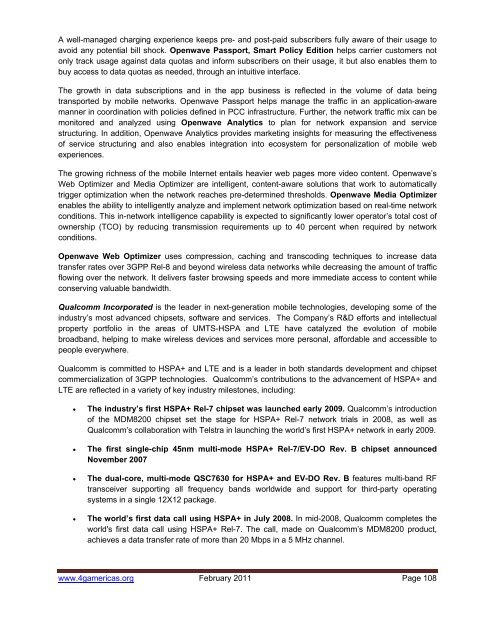Create successful ePaper yourself
Turn your PDF publications into a flip-book with our unique Google optimized e-Paper software.
A well-managed charging experience keeps pre- and post-paid subscribers fully aware of their usage to<br />
avoid any potential bill shock. Openwave Passport, Smart Policy Edition helps carrier customers not<br />
only track usage against data quotas and inform subscribers on their usage, it but also enables them to<br />
buy access to data quotas as needed, through an intuitive interface.<br />
The growth in data subscriptions and in the app business is reflected in the volume of data being<br />
transported by mobile networks. Openwave Passport helps manage the traffic in an application-aware<br />
manner in coordination with policies defined in PCC infrastructure. Further, the network traffic mix can be<br />
monitored and analyzed using Openwave Analytics to plan for network expansion and service<br />
structuring. In addition, Openwave Analytics provides marketing insights for measuring the effectiveness<br />
of service structuring and also enables integration into ecosystem for personalization of mobile web<br />
experiences.<br />
The growing richness of the mobile Internet entails heavier web pages more video content. Openwave’s<br />
Web Optimizer and Media Optimizer are intelligent, content-aware solutions that work to automatically<br />
trigger optimization when the network reaches pre-determined thresholds. Openwave Media Optimizer<br />
enables the ability to intelligently analyze and implement network optimization based on real-time network<br />
conditions. This in-network intelligence capability is expected to significantly lower operator’s total cost of<br />
ownership (TCO) by reducing transmission requirements up to 40 percent when required by network<br />
conditions.<br />
Openwave Web Optimizer uses compression, caching and transcoding techniques to increase data<br />
transfer rates over 3GPP Rel-8 and beyond wireless data networks while decreasing the amount of traffic<br />
flowing over the network. It delivers faster browsing speeds and more immediate access to content while<br />
conserving valuable bandwidth.<br />
Qualcomm Incorporated is the leader in next-generation mobile technologies, developing some of the<br />
industry’s most advanced chipsets, software and services. The Company’s R&D efforts and intellectual<br />
property portfolio in the areas of UMTS-HSPA and LTE have catalyzed the evolution of mobile<br />
broadband, helping to make wireless devices and services more personal, affordable and accessible to<br />
people everywhere.<br />
Qualcomm is committed to HSPA+ and LTE and is a leader in both standards development and chipset<br />
commercialization of 3GPP technologies. Qualcomm’s contributions to the advancement of HSPA+ and<br />
LTE are reflected in a variety of key industry milestones, including:<br />
� The industry’s first HSPA+ Rel-7 chipset was launched early 2009. Qualcomm’s introduction<br />
of the MDM8200 chipset set the stage for HSPA+ Rel-7 network trials in 2008, as well as<br />
Qualcomm’s collaboration with Telstra in launching the world’s first HSPA+ network in early 2009.<br />
� The first single-chip 45nm multi-mode HSPA+ Rel-7/EV-DO Rev. B chipset announced<br />
November 2007<br />
� The dual-core, multi-mode QSC7630 for HSPA+ and EV-DO Rev. B features multi-band RF<br />
transceiver supporting all frequency bands worldwide and support for third-party operating<br />
systems in a single 12X12 package.<br />
� The world’s first data call using HSPA+ in July 2008. In mid-2008, Qualcomm completes the<br />
world's first data call using HSPA+ Rel-7. The call, made on Qualcomm’s MDM8200 product,<br />
achieves a data transfer rate of more than 20 Mbps in a 5 MHz channel.<br />
www.4gamericas.org February 2011 Page 108

















